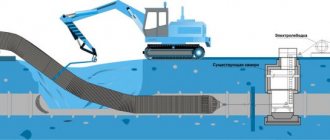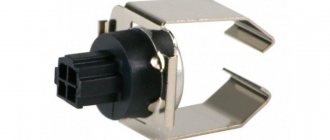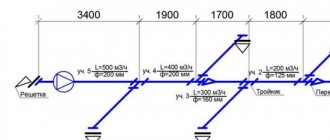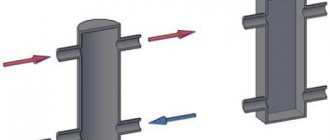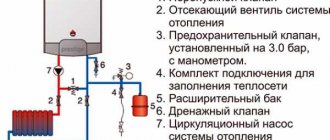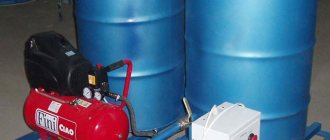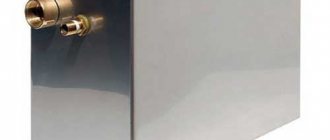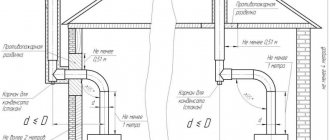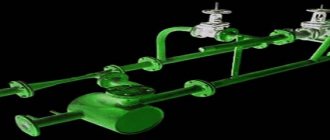Pipeline laying diagrams
This type of diagram characterizes the method of laying system pipelines depending on the method of connecting heating devices to them. There are 3 main schemes for laying pipes of a water heating complex:
- Single-pipe;
- Two-pipe;
- Collector-beam.
In a single-pipe scheme, radiators are connected to the supply pipeline in series - the coolant passes through each device in turn, from the last device the return pipeline returns cooled water to the boiler.
Here there is a gradual decrease in temperature from the first battery to the last on the line, so the length of the branches is limited - it is not recommended to place more than 4 - 5 radiators on one line. In addition, difficulties arise in temperature control - when the coolant flow is limited, the temperature on all radiators located behind the adjustable one decreases. You cannot disconnect the batteries either - in this case the circulation along the entire line will stop.
The single-pipe circuit has a modified version - the change is made by installing a bypass on each radiator - a jumper of equal or smaller diameter between the inlet and outlet of the coolant from the battery.
Through this bypass, part of the hot water bypasses the heating device and enters the next one, mixing with the return flow from the first one (on which the jumper is installed). This optimization somewhat equalizes the temperature on heating devices and makes it possible to partially regulate and turn off individual batteries.
The two-pipe scheme is more advanced from a technical point of view. In it, the radiators are connected in parallel to two independent pipelines - supply and return (return). This allows the batteries to operate with minimal mutual interference; the devices are easy to control and can be turned off for repair or cleaning.
The two-pipe system has 2 varieties - a tee (dead-end) scheme and a Tichelman loop (passing scheme). Most experts agree that the Tichelman passing system is more efficient in operation. You can read more about the two-pipe water heating scheme in a special article.
The collector (radial) circuit is implemented by connecting radiators with separate connections to distribution manifolds. When installing a system of this type, increased pipe consumption is observed. The advantage of this scheme is that the control of heating devices is concentrated in one place - on the collector unit. But in this case, difficulties may arise in laying pipelines - a massive bundle of pipes departs from the collector unit, which are difficult to hide, especially in the groove. In addition, when using a collector system, increased hydraulic resistance occurs - this may require the installation of a more efficient circulation pump.
Basic schemes are often combined with each other. For houses with 2 or more floors, a popular scheme is a system with 2 vertical risers. They are a two-pipe component of the circuit; either single-pipe floor-to-floor branches or floor-to-floor collector groups are connected to them.
A separate water heating scheme is a complex of heated floors. It includes a special unit and operates in low-temperature mode. The pipelines of the circuits are laid according to 2 main schemes - in rows (coil) and in a spiral (snail). You can read more about the installation of water heated floors here.
Choosing pipes
Modern design of heat supply systems is 95% based on the use of plastic, polyethylene, and corrugated stainless steel pipes.
Each of them has its own disadvantages and advantages. Metal and copper pipes also have the right to exist, but due to their tendency to corrosion, high cost, and complexity of installation, their use is declining. Preference is given to plastic products that are not inferior in characteristics. For detailed recommendations on choosing heating pipes, watch the video.
Video:
Metal-plastic, polypropylene pipes
Metal-plastic pipes are widely used when laying water supply, heating, and heated floors. They bend well, are easy to install, can withstand significant temperatures and pressure, and have a budget price.
Metal-plastic consists of heterogeneous layers with different coefficients of thermal expansion. Application experience shows that when using metal-plastic for hot water supply, the layers separate, and the pipe fails after 5-7 years. This type of installation of heating pipes in the floor is not recommended.
Polypropylene pipes
Polypropylene has no layers and easily withstands the service life guaranteed by the manufacturer. The main disadvantage is the need to strictly observe the temperature and heating time with a soldering iron during installation. Polypropylene has low thermal conductivity and cannot be used for heated floors.
Corrugated stainless steel pipe
Corrugated stainless pipe, developed using innovative technologies, is recommended for laying heat supply networks. When using such a product, it is easy to install floor heating in a new building or replace old pipelines.
Corrugated stainless steel pipe
Here are some advantages of its use:
- bends easily;
- provides simple connection of fittings, facilitates and speeds up the installation process;
- the corrugated structure compensates for fluctuations in linear dimensions and hydraulic shocks;
- durability;
- does not corrode, there is no sediment on the walls.
PE-X pipes
PE-X – products made from cross-linked polyethylene. Cross-linking is the process of imparting strength to the connection of polyethylene molecules, obtaining a round-shaped product. The pipes are marked (GOST 52134-2003 for Russian manufacturers) indicating the stitching method:
- PE-Xa,
- PE-Xb,
- PE-Xc.
PE-Xa molecules are cross-linked by peroxides. This is an expensive, time-consuming process. PE-Xb – steam crosslinking. The process is simple, so these are the cheapest products in the PE line. PE-Xc - cross-linking with radioactive isotopes.
Polyethylene allows oxygen to pass through well, which allows bacteria to grow inside the heating elements. To prevent oxygen from passing to the coolant, the product is made multilayer. A layer of EVOH is inserted inside.
Innovative developments have led to the creation of polyethylene that is more resistant to high temperatures - PE-RT. In modern construction, heating pipes in an apartment are laid across the floor using PE-RT.
Important! It is recommended to choose a pipe marked PE-RT/EVOH/PE-RT; it is five-layer and does not allow oxygen molecules to pass through to the coolant
| Name. | Diameter, mm. | Wall thickness, mm. | Price, rub./meter |
| PE-Xb | 16.0 | 2 | 59 |
| PE-X/EVOH | 16.0 | 2 | 28 |
| Elsen PE-Xa | 25 | 3,5 | 208.6 |
| PexPenta PE-Xc | 16 | 2 | 50 |
| Stainless steel corrugated pipe S9 304 | 15 | 95 | |
| Casing, HDPE corrugated for polyethylene 16 mm | 25 | 12 |
Equipment options, how heat consumption is calculated and payment methods for services
In order to understand how much coolant you consume to heat a house with a large number of apartments, the best option would be to install a house meter. To calculate the payment for consumed heat, readings are taken from the meter. They are divided by the number of apartments in the building and their area. A house meter makes it possible to pay for heat only in the cold season and it is possible to reduce the amount of incoming energy into the heating systems of buildings.
House heat meter
This leads to you saving your finances when favorable living conditions arise. The cost of this type of heating is indicated by local authorities. To install a home meter, first of all, gather the residents for a meeting and decide whether everyone agrees to switch to a different heating method. It is also worth seeking help from specialists to assess the feasibility of a home heating system.
Such a heating system in a five-story building or in a house with fewer or more floors allows heating at certain times of the year and paying bills for actual energy consumption. Such a heating system for Khrushchev houses implies that a meter is installed to control the heat, from which monthly readings are taken. However, this is the most complex heating system for a five-story building for profitable heating. There are a lot of nuances that need to be observed, and there is no guarantee that local authorities will release your home from control.
Heating scheme for a multi-storey building
Equipment
So, we are going to install water heating with our own hands. What main elements will our scheme include?
Boiler
Domestic gas heating boilers are the cheapest to operate. In the Moscow region, the cost of heating a 200 m2 house with main gas does not exceed 3,000 rubles per month.
Boilers can be volatile (with electronic ignition) and non-volatile (using piezo ignition and a pilot burner). The former are noticeably more economical - the pilot burner consumes up to 20% of the total amount of gas.
In second place in terms of efficiency are solid fuel boilers. Coal and firewood will be an excellent solution where there is no main gas. However, using solid fuel requires frequent loading: you will have to light the boiler at least twice a day.
There are, however, a number of ways to solve this problem.
- Gas-generating solid fuel boilers split the fuel combustion process into two stages. Initially, it smolders with limited air access, forming flammable pyrolysis gas; then this gas is burned in its own furnace. A gas generator boiler is capable of operating on one load not for 2-5, but for 8-12 hours.
- Top-burning devices use the smoldering of a thin top layer of coal or wood. A coal boiler can operate for up to 5 days without maintenance or cleaning.
- A simple and universal solution is to use a heat accumulator (a thermally insulated container with a volume of 300-2000 liters). Working at full power, the boiler heats the water in the tank after lighting. Over the next few hours, the accumulated thermal energy is gradually released to the heating devices.
Finally, solar and electric boilers differ little in heating costs. They provide the maximum cost per kilowatt-hour of heat. In addition, it is not possible to provide the power required for heating with electricity everywhere.
Pipes
Their choice is determined by whether we are talking about central or autonomous heating.
The optimal material for central heating is steel pipes of several types.
- Black steel is cheap but susceptible to corrosion. In addition, steel risers and connections require a lot of time and effort for installation. Connections are most often made by welding.
- Galvanized steel is protected from corrosion by a zinc layer; It would be correct to assemble a galvanized liner ONLY on threads. Welding breaks the protective coating, including inside the pipe.
- Finally, a wonderful material is corrugated stainless steel. The pipes are connected using compression fittings with silicone seals and are easy to bend.
Why steel? Because in the central heating system you are not protected from exceeding the design temperature and water hammer. It is better to overpay when installing heating, and not when eliminating the consequences of a dirty boiling water leak.
But autonomous heating means that all parameters are constant and under your control. Hence the choice of materials:
- Metal-plastic with press fittings.
Important: it is better not to use compression fittings with union nuts on heating and hot water. After several heating and cooling cycles, they begin to leak.
- Polypropylene. Preferably reinforced: reinforcement not only increases the tensile strength of the pipe, but also reduces its thermal expansion.
- Cross-linked polyethylene. In addition to strength, these pipes have another advantage: they are flexible and are supplied in coils up to 500 meters long, which is useful for radial distribution with laying pipes in a screed.
Heating devices
And here it is worth separating central and autonomous heating.
In central heating systems, it is better to use steel tubular radiators, steel convectors and bimetallic radiators. Aluminum is not desirable.
And not only from the point of view of strength: the instructions for the use of aluminum radiators specifically stipulate the ability of this metal to accelerate destruction in combination with copper water supply. Metals form a galvanic couple.
Since you can’t know what your neighbors’ eyeliners are made of, it’s better not to take risks.
But for autonomous heating, aluminum radiators are undoubtedly the best choice.
Safety
- Expansion tank. It accommodates excess coolant during its expansion accompanying heating.
- Safety valve - additional insurance against circuit overflow. The valve is activated and releases excess coolant when its pressure reaches a preset threshold value.
- A pressure gauge or thermomanometer is installed for visual monitoring of parameters.
- An automatic air vent or a manual air vent is mounted at the highest points of the circuits and in air pockets.
Main types of water heating wiring
Today, there are several main options for piping around the house when using water heating:
Single-pipe. The so-called “Leningradka”, in which one pipe connects all the heaters in the house in the direction of flow of the coolant. This scheme is chosen for its simplicity, minimal financial (the price of highways is generally lower) and labor costs.
But at the same time, the heating of the radiators is uneven, and it is impossible to regulate the temperature in each of the batteries;
- Two-pipe
. The heating radiators are connected by two pipes laid parallel to the movement of water in the system. The advantages include the ability to quickly adjust the temperature, quick and uniform heating of rooms, accessibility; - Manifold pipe arrangement
. It has its own supply and return pipelines, connected together using special distribution manifolds. Features: beautiful appearance, full control over all batteries in the house from the distribution cabinet.
The main advantages of water heating of a cottage
As you can see in the photos and videos of country houses on our website, water heating schemes are used quite often in our country.
There are simply a huge number of reasons for such wide distribution:
- Possibility of performing installation work on heating a house at any stage of construction. In addition, even in a finished house, water heating can be installed without any problems;
- The water itself has excellent qualities if used as a coolant. High thermal conductivity, availability and low cost, along with unique heat capacity, make water the best choice;
- Versatility, the ability to use different types of fuel to heat the coolant in a heating circuit;
- A large selection of pipe routing options for water heating schemes. You can choose a certain type depending on a lot of parameters, starting from the area of the cottage and ending with financial capabilities;
- A variety of equipment for arranging home heating;
- Accurate and quick adjustment of air temperature in each room of a private house. This is ensured by the installation of special equipment, namely thermostats and shut-off valves.
Open
Principle of operation
Schematic diagram of an open type heating system
Open heating systems are independent, since the coolant circulates through the circuit as a result of natural pressure, without the use of a circulation pump. As a rule, solid fuel boilers, including gas generators, as well as stoves and fireplaces with a water jacket (a container for heating water) can be used as a heater in such situations.
In terms of the number of circuits, the circuit can be either one-pipe or two-pipe, but it is necessary to maintain a slope during installation of 0.01% from the starting point of coolant supply. Since such calculations are quite difficult to make, we can proceed from calculations of a slope of 8-10 mm per linear meter.
Open expansion tank made of steel
For the normal functioning of such a circuit, the expansion tank must be located above the horizontal coolant supply pipe in order to create columnar pressure. That is, hot water from the boiler expands into the circuit.
But when the pressure exceeds the norm, it is simply discharged into the expansion tank, and when the coolant cools, as a result of the column pressure, it returns back to the circuit. Such containers in private homes are usually installed in the attic.
The circulation of water in such systems occurs quite slowly, but this allows for uniform heating of the pipes, which in such cases must be at least 40 mm in diameter. For this reason, such circuits are most often made of steel, although they can also be made of polypropylene.
Circulation pump insert. Photo
But the instructions do not at all prevent you from installing an auxiliary pump in an independent open-type system to increase efficiency. As you can see in the top photo, there is a shut-off valve on the main pipe between the piping for the pump.
It is blocked, and the water begins to move through the circulation pump, and when an emergency shutdown occurs, the main pipe opens and the circuit is blocked. Increasing the coolant circulation rate significantly affects the efficiency of heating the room.
Advantages
- The main advantage of a single-pipe or two-pipe open-type system is its complete independence from third-party energy sources (power lines, diesel or carburetor electric generator).
- Installation of open systems does not require special knowledge, as well as a license or permit when installing and connecting a gas or electric boiler.
- Solid fuel boilers or stoves, as a rule, are unpretentious in the use of fuel - in addition to coal and firewood, it can be any organic material in a dry state.
Flaws
- The water in the expansion tank can freeze, so it needs to be insulated, but adding antifreeze to prevent the liquid from freezing is strictly prohibited.
- When air pockets form in these places, the pipes undergo corrosion, since natural pressure is not able to push air through. To eliminate blockages, you need to pump water into the circuit until all the air is released.
- Low efficiency.
Selection of heating radiators. Cast iron, steel, bimetallic or aluminum radiators.
After deciding to replace old batteries, the question arose: how to choose heating radiators? The primary factor influencing the choice was the ratio of the cost of the heating radiator to its quality and heat transfer. In principle, as when choosing any thing, I weigh the pros and cons for myself, relate it to the price and make my choice. At the moment, cast iron, steel, bimetallic and aluminum radiators are available for sale. Let's look at them each separately.
Cast iron heating radiators.
Advantages:
- The large thickness of the walls of the cast iron radiator, which contributes to the durability of the product, in conditions of the presence of a large number of abrasive particles in the coolant.
- High resistance to corrosion, which is due to the physical properties of cast iron and is associated with the formation of a protective layer of “dry rust” on the walls.
- High thermal inertness and heat accumulating properties.
- Has the longest service life.
Flaws:
- Significant weight makes installation difficult and requires a more serious fastening system.
- The situation with cost is twofold - in the middle price category but very unprepossessing in appearance, or made in exquisite patterns like forging but having a significant cost.
Steel heating radiators.
Advantages:
Low weight, and as a result ease of installation.
Flaws:
- Average heat transfer compared to aluminum and bimetallic radiators.
- It is necessary to constantly have a carrier in the radiator, since its absence causes rapid oxidation and, as a consequence, the formation of rust and rapid destruction.
- Low operating pressure, from 6 to 10 bar.
- Low resistance to pneumatic shocks and hydraulic shocks.
Aluminum heating radiator.
Advantages:
- For me personally, this is the most aesthetically pleasing appearance.
- Low weight and easy installation.
- Fast heating when feeding media.
- The highest heat transfer rate (even in the heat transfer - cost ratio).
- Quite high working pressure of 16-20 bar.
- The ability to set the required number of sections depending on the size of the room.
Flaws:
- The main disadvantage is poor corrosion resistance, which imposes increased requirements on the quality of the coolant.
- When connected to other types of metals (most of all copper), a galvanic couple is formed and, as a result, destruction of the connection point.
Bimetallic heating radiators.
Advantages:
Bimetallic heating radiators, in principle, have all the advantages of aluminum radiators, except that the heat transfer is slightly lower, but at the same time eliminating its main disadvantages. The steel located on the inside of the radiator is less susceptible to corrosion and, in addition, no galvanic couple is formed during connection. Additionally, it has higher operating pressure characteristics.
Flaws:
The only drawback, in my opinion, is the slightly higher cost compared to aluminum, but this did not stop me and the choice fell on bimetal.
In conclusion, without brands, Italian manufacturers won based on reviews from users who had already installed them, and over time I did not regret my decision.
Aesthetics and comfort
The aesthetic side of the issue also plays an important role. Increasingly, consumers are placing increased demands on the interior of their home. Designer renovations have come into fashion, implying that the interior matches a certain style.
At the same time, not every style is able to accommodate “scoop” risers in every room, and leaking pipes can turn expensive repairs into a pitiful sight quickly enough.
The horizontal arrangement of the distribution pipes allows you to hide them in the floor screed, which significantly increases the visual appeal of the room and the possibilities of interior decoration.
The horizontal arrangement of the distribution pipes allows you to hide them in the floor screed, which significantly increases the visual appeal of the room and the possibilities of interior decoration.
In addition, modern people no longer want to put up with conditions and adapt to the climate. When investing in real estate, the buyer wants to get housing that is comfortable in all respects.
In winter, the temperature regime is especially changeable: after severe frosts, sharp warming may occur, and the temperature increases several times. Naturally, if the radiators heat up as before, the apartment will become hot.
You will have to open the windows and create drafts, and the question arises: why pay for heat when it is unnecessary? Horizontal systems allow you to regulate the temperature of each individual apartment, and radial systems allow you to regulate the temperature of each individual room.
Advice! Using heat meters allows you to take into account only the heat you need and avoid paying for an overheated room.
Tips for minimizing heating costs
In addition to upgrading the autonomous heating installation, you can perform a number of actions, the result of which will lead to a reduction in current operating costs and payment for housing and communal services. Considering the specific layout of the heating system in a Khrushchev building, installing heat meters in an apartment is impractical. This is due to the absence of a central riser, i.e. Even for a one-room apartment you will have to install at least three meters - in the bathroom, kitchen and living room.
The total cost of installing one device can range from 25 to 30 thousand rubles. The way out of this situation is to install a common house meter. It will take into account the amount of thermal energy consumed for the entire building. Fortunately, the centralized scheme characteristic of all types of heating in Khrushchev allows this to be done. As an additional function, a mode for adjusting the coolant supply depending on the outside temperature can be provided.
For the central heating scheme of a five-story Khrushchev building, you can install a balancing riser. It will perform the functions of uniform distribution of coolant throughout all floors of the house. However, which project is carried out only in agreement with the housing office, since it falls under the category of changing the principle of hot water supply.
If the house has old steel pipes and radiators, it is recommended to carry out periodic chemical and mechanical cleaning. Before this, socialists must carefully study the heating scheme of a five-story Khrushchev building in order to draw up a work plan. It is recommended to clean the apartments on the upper floors. As a result, the coolant flow through the pipes and radiators will improve.
Some diagrams of Khrushchev heating systems and their design provided for hidden installation of radiators. This installation method is effective only if the external walls are insulated.
As an alternative type of heating, you can watch the video on installing electric heating elements in radiators.
Autonomous heating is good for those who have it. But the rest of the residents pay for the heating of common areas and common risers pass through apartments with autonomous heating and heat them. Therefore, they do not turn on the heating during the autumn and spring months. In addition, the entire frame of the house is heated by general heating. The cost of heating for an autonomous system is 10 times less. There is a theft of heat, permitted from above.
Over the past months, heating costs (at normal - 1621.95) 1829.34-November 16, 2414.69-December 16, 2656.10-January 17, 2895.22-February 17. Why? Is there some kind of individual heating in the house on Polyustrovsky Prospekt, building 11? During this period, there was no heating at all for several days due to accidents. An example of another nearby house: (norm - 1621.95) 634.41-November 16, 1305.33-December 16, 1224.12-January 17, 1207.1-February 17. The truth is that they treat people conscientiously and recalculate all losses, conduct conversations with defaulters, sue, withdraw money from the compensation of defaulters, and do not distribute debts to conscientious tenants.
Additional measures
Even after new heating radiators are installed for the apartment, prices for which depend on their type, residents of Khrushchev may note the insufficient efficiency of the central heating supply.
Single-pipe heating systems in Khrushchev. Heating circuit - bypass
The hot air distribution system must be adjusted so that the rooms are heated with sufficient air at the lowest possible temperature and flow out of the diffusers without causing a noticeable rush. Excessive airflow will be felt as discomfort, which is aggravated by increased noise in the installation.
The heating parameters of the fireplace - temperature and air flow intensity - must be specified in the installation design, but during use, adjustments are necessary due to predictable changes in operating conditions. Even a very large fan will not provide this.
Autonomous heating in Khrushchev
To radically solve the problem of cold radiators and low air temperatures in a Khrushchev building, the apartment owner can implement an autonomous heating project.
The project involves the installation of a separate boiler in the apartment and the presence of a well-developed project that regulates the technical conditions under which the autonomous heating system will operate. If the heating of the fireplace is insufficient, either the temperature of the heating air or the intensity of its inflow must be increased. Therefore, a house heated by a fireplace must have very good thermal insulation: this will not only save fuel, but also provide more comfort for heating users. This reduces the demand for heat both during severe frosts and during the remaining periods of the heating season, which will reduce the most important heating parameters, that is, temperature and air flow.
Adjusting the heating power depends on the actual conditions, which we obtain mainly by changing the burning intensity in the fireplace while maintaining a constant flow. However, sometimes it is necessary to adjust the amount of air, such as initially adjusting the flow or turning off some rooms from heating.
The boiler for Khrushchev is selected in accordance with the area of the apartment.
Often, a device with a power of 7-8 kW is enough to heat a two-room apartment with an area of sixty square meters. According to the regulations, the boiler must have a closed combustion chamber, be equipped with a coaxial chimney and be installed in accordance with the recommendations specified by the manufacturer.
For this purpose, dampers are installed on individual branches of the pipeline system. Swivel arms, hidden in pipes in the ceiling or behind screens on the walls and combined with elastic straps, allow airflow to be dampened or increased. For precise flow control, anemostats are used, i.e. diffusers with an adjustable slot through which air flows.
Heating diagram with two pipes
Note. Excessive airflow suffocation increases airflow noise, which is undesirable, especially in the bedroom. A fireplace insert is usually selected for its capacity and appearance. In theory, the rated power of a fireplace should correspond to the thermal energy demand in a particular building. However, the fireplace is not a gas boiler, and constantly maintaining the rated power is almost impossible.
Conversion of the circuit
In addition to the boiler, the existing circuit will have to be converted.
Used heating batteries and new radiators can be connected to it, which are connected with pipelines in accordance with the heating diagram. Depending on the required thermal power, low radiators installed under the window sill, as well as standard radiators, can be used in the heating circuit. Due to the fact that for the fireplace to operate, it requires work related to shooting and maintaining the fire, we must also pay attention to the following features of the cartridge, which affect the ease of operation. Combustion chamber size
In a larger chamber, it is unlikely to add and provide heat for longer than a small chamber. The fixture in the chimney must ensure that the chimney is closed.
In addition to the air that, after heating, is distributed around the house, the fireplace must also be included in what is necessary for the combustion process. Through air distributors, air enters the room where the fireplace is located, and then under the fireplace through the hole under the fireplace door. The air is supplied directly from outside the house under the fireplace. . Regardless of aesthetic values, good thermal insulation of the cartridge must be ensured so that the housing does not overheat.
Electrical wiring installation
So:
- Of course, at the moment there are numerous videos of correct wiring, but we will only focus on certain points. It is advisable to make grooves in the upper part of the wall, right under the ceiling. Of course, some people make it easier for themselves and place the electrical wiring in the screed. If you are pouring a new screed, then this option is certainly quite convenient. But if the wiring is damaged, you will have to knock out the tie, which in certain cases may lead to the need to completely replace it. In addition, the risk of electric shock increases when the room is flooded.
- Your electrical wiring diagram in a 2-room apartment must necessarily contain junction boxes. It is advisable to place them at the entrance to the room on the wall closest to the door handle. This is due to the fact that this is where the room light switch will be located and from here it is much more convenient to carry out subsequent wiring.
- When laying several wires of different groups in one groove at once, it is advisable to separate them with fireproof material. This could be a layer of plaster or a corrugated metal pipe. This will prevent damage to several wires at once if one of them catches fire or overheats.
- When connecting sockets, switches and other electrical receivers, you should leave a small supply of wire, sufficient for re-cutting the wire and reconnecting.
Replacement of external sewerage
Trenchless sewer replacement
The problem of worn-out external sewer lines often leads to serious accidents. Therefore, there is an urgent need for emergency emergency repairs. Many city residents are familiar with a similar picture: a part of the street blocked off with a large amount of digging equipment and piles of earth near an open pit. Replacing sewer pipes of an external pipeline using an open method is associated with great inconvenience and difficulty. After all, often at the location of sewer pressure and free-flow pipelines there are other underground communications of water supply, electrical power cables, and communications.
What can be done
What do they do when an old part of any design becomes completely unusable? Throw it away and replace it with a new one. It may not be cheap, but it guarantees stable operation for many years.
So, in our case, replacing hopelessly outdated elevator units with modern individual heating units (IHP) with weather regulation is the only correct solution in the current situation in our country.
More and more condominiums in various cities of Ukraine are making similar decisions: Lviv, Cherkassy, Vinnitsa, Odessa, Lutsk, Kyiv. Members of these condominiums have already experienced the benefits of weather-controlled heating points, which allow efficient use of heat and, therefore, savings on heating bills. In addition, the level of comfort of residents in such houses increases significantly.
Functioning of the heating system of an apartment building
Autonomous heating systems of a multi-storey residential building perform one function - timely transportation of heated coolant and its adjustment for each consumer. To ensure the possibility of general control of the circuit, a single distribution unit with elements for adjusting the parameters of the coolant, combined with a heat generator, is installed in the house.
An autonomous heating system for a multi-storey building necessarily includes the following units and components:
- The pipeline route through which the working fluid is delivered to apartments and premises. As already mentioned, the pipe layout in multi-story buildings can be single- or double-circuit;
- KPiA - control instruments and equipment that reflects the parameters of the coolant, regulates its characteristics and takes into account all its changing properties (flow, pressure, inflow rate, chemical composition);
- A distribution unit that distributes heated coolant through pipe lines.
A practical heating scheme for a residential multi-storey building includes a set of documentation: design, drawings, calculations. All documentation for heating in an apartment building is drawn up by the responsible executive services (design bureaus) in strict accordance with GOST and SNiP. Responsibility for ensuring that the centralized central heating system is operated correctly rests with the management company, as does its repair or complete replacement of the heating system in an apartment building.
Alternative sewer replacement method
An alternative solution for the open method of repairing external pipelines is trenchless sewer repair. In dense urban areas, this replacement method has gained popularity due to its obvious advantages:
- Reducing work costs. With trenchless replacement, there is no need to use earthmoving equipment to develop a pit and remove soil;
- Reducing the duration of sewer replacement work;
- Sewer replacement is carried out by a small number of workers;
- To carry out the work, there is no need to obtain a special permit - an earthwork warrant;
- There is no risk of damage to other utilities. With the trenchless method, the new sewer pipeline line runs along the old route;
- Possibility of laying a pipeline of a larger diameter, which increases the sewerage capacity;
- No interference for the movement of city vehicles and pedestrians.
Trenchless sewerage replacement in urban environments makes it possible to quickly restore emergency sections of pressure sewerage. What is the trenchless replacement method?
Rehabilitation method – replacement of sewerage system “pipe in pipe”
There are several types of trenchless sewer line replacement. The most popular method is to lay a new sewer system using the “pipe-in-pipe” principle. Sewer pipes that have become unusable are replaced with special polyethylene pipes. For this work, special equipment is used - a pipe pulling device with a pneumatic drive. Repair work is carried out from one sewer well to another. Modern technologies make it possible to replace a significant length of external sewer pipeline in two to three days.
Using the trenchless replacement method, you can repair not only sewer networks, but also replace water pipes.
Providing heat to apartment buildings with a centralized heating system
As is known, the provision of heat to a significant portion of the housing stock is carried out centrally. And, despite the fact that in recent years more modern heat supply schemes have appeared and are being implemented, central heating remains in demand, if not among owners, then among developers of multi-apartment housing. However, it should be noted that many years of foreign and domestic experience in using this heating option have proven its effectiveness and right to exist in the future, subject to trouble-free and high-quality operation of all elements.
A distinctive feature of this scheme is the generation of heat outside the heated buildings, the delivery of which from the heat source is carried out through pipelines. In other words, centralized heating is a complex engineering system distributed over a large area, providing heat to a large number of objects at the same time.
Compatibility of heated floors with floor materials
Let's immediately determine under what materials it is advisable to place a heating film. In 90% of cases, standard ceramic tiles are used, and this is correct. Firstly, it accumulates heat well and gradually releases it into the room. Secondly, it is not afraid of overheating, does not dry out and does not deform like wooden materials.
If you still want to install laminate, let it be a special series designed for use with heated floors. It is undesirable to use cork coating - it has very poor thermal conductivity. Since the infrared heated floor does not heat up above 45˚C, it can also be laid under quartz-vinyl tiles. It is recommended to ensure that the temperature of the coating above the heating film does not exceed 28˚C.
Central heating
The centralized heating system in Khrushchev was implemented using single-pipe piping of radiators. According to the diagram, the coolant spreads along the circuit, starting from the fifth floor. As it passes through the system, the cooled coolant enters the basement (basement). At the same time, room heating radiators located on different floors of the Khrushchev building will differ greatly in temperature and heat transfer.
In addition to uneven heating, the heating scheme of Khrushchev houses also has other critical shortcomings:
- inability to regulate the supply of coolant in various heating devices (the only solution is to install bypasses on each radiator);
- Due to physical wear and tear, old heating batteries connected to the circuit are covered with limescale from the inside; they cannot work fully, since the normal circulation of the coolant is blocked by blockages and scale.
Residents of Khrushchev can solve the problem of inefficient heating by installing modern heating radiators and pipelines in their apartments
To understand how to choose the right heating batteries for an apartment, it is important to study the performance characteristics of heating devices made of different metals. In recent years, polymer pipelines and bimetallic radiators have been in demand
But the owner can choose any other type of heating device that suits his financial capabilities and requirements.
It is most rational to replace heating devices in all apartments connected to one riser.
Installing new heating devices on all floors will cost a lot of money, but such measures will give tangible results instantly.
Closed
Operating principle
Scheme of closed heating systems
Closed-type systems in most cases operate from gas, electric, diesel and solid fuel heating boilers and are directly dependent on electricity. Regardless of the fuel the boiler itself operates on, the circulation pump operates exclusively using electricity.
Nevertheless, such systems have gained universal approval and popularity due to their high efficiency and reliability, as well as the automatic control method - in emergency situations on power lines, a diesel or carburetor generator can become a source of electricity.
Closed expansion tank
Such a system operates on the principle of deaeration or automatic adjustment of the maintained pressure using a special, hermetically sealed expansion tank. This container consists of two sectors separated by a membrane made of heat-resistant rubber.
One compartment contains air or nitrogen (if the injection was carried out by the manufacturer), and the coolant enters the second compartment through a safety valve if its pressure exceeds a specified threshold. When the coolant cools down, the pressure in the system drops and the gas squeezes the liquid accumulated there out of the reservoir back into the circuit.
Advantages
- The expansion tank in such systems can be installed anywhere (above, at the level or below the heating circuit) - in any case, an electric pump is responsible for the circulation of the liquid.
- There is no need to control the volume of coolant in the system (it is regulated automatically).
- Antifreeze can be used to prevent the system from defrosting.
- To heat the circuit, you can use backup boilers, for example, in addition to the main gas boiler, install a solid fuel or electric unit. Also, all these heaters can work together as a group.
- All parameters of the system are adjusted automatically, therefore, it can be left unattended for a long period by setting the mode you need.
Heating diagram of a multi-storey building - how the supply occurs in the heating system of high-rise buildings
An apartment in a multi-storey building is an urban alternative to private houses, and a very large number of people live in apartments. The popularity of city apartments is not strange, because they have everything a person needs for a comfortable stay: heating, sewerage and hot water supply. And if the last two points do not need special introduction, then the heating scheme of a multi-storey building requires detailed consideration. From the point of view of design features, the centralized heating system in an apartment building has a number of differences from autonomous structures, which allows it to provide the house with thermal energy during the cold season.
Battery in the wall: leave it or dismantle it?
There are many apartment buildings with an “in-wall” heating system scattered throughout the former Soviet Union. They can be found both in Moscow and in Murmansk, St. Petersburg, Chelyabinsk, as well as in many cities of Belarus and Ukraine. But what is this “battery in the wall” - a whim or stupidity of Soviet architects? Or an innovation that appeared too early? And what to do with it today: change it or leave it as is?
Reasons for the appearance of houses with in-wall batteries
In Khrushchev and Brezhnev times, when such housing was built, the main task of architects and builders was to provide the population with their own living space as quickly as possible. And the formation of a centralized heating system at the stage of pouring reinforced concrete structures was a completely logical step.
Plus, batteries inside walls are a truly innovative and practical solution. With proper pipe laying and high-quality reinforced concrete production with good insulation, it is not the street air that is heated, as many believe, but the slabs themselves.
And according to the technology, heat should be reflected inside the premises. As a result, much less energy is required for comfortable heating. And the air in the rooms is not as humid as with conventional wall-mounted radiators. Today, such a technological solution is increasingly used in European countries precisely because of its cost-effectiveness and practicality.
Read also: Kitchen zoning design. Examples, photos, features
In the Soviet years, the technology of placing batteries inside walls was quite widespread and covered many regions. Such houses were built from series 91, 121, 1-515, 464, 1605 and many others. Each research institute sought to “improve” the design. And in some, only the riser was laid inside the slabs, in others, the entire heating system was installed. In some projects, pipes were installed in the facade walls, while in others, on the contrary, they were installed exclusively in interior walls.
Battery in the wall: how to get rid of it and is it worth it?
The main problem with such batteries is the inability to shut them down when it gets hot. Plus, houses age and naturally the pipes in them do too. An outburst can happen at any moment. And if in a building with “open” heating pipes, they can be replaced with new ones without any noticeable problems. Then you will have to work hard with the “walled up” ones.
Moreover, in most cases, the first thing you will need to do is order a project for rebuilding the heating system, and go through many approvals. Design and estimate documentation can be done externally, but you will have to go to the Housing Office for approvals. It is best to entrust the work to them.
How can you reduce heating costs?
- Installing a solid fuel or electric boiler - savings, depending on the current state of affairs, can reach 50%.
If I live in an apartment building
- if a condominium has been created in the building, decisions are made by the general meeting in accordance with the charter of the condominium;
- if there is no condominium in the building, decisions are made with the consent of all co-owners of the apartment building.
At the house level
- Installation of communal heat and electrical energy metering devices - savings of 15%.
- Arrangement of an individual heating point (weather regulator) with a thermoregulation system - savings of 40%.
- Switching to electric heating at home - the effect depends on additional factors.
- Modernization of the heating system - savings of 25%.
At the apartment level
It is important to understand here that we are talking about very relative figures. It is quite possible, for example, that the installation of apartment meters will lead to an increase in payments if energy-efficient measures are not taken for the entire house
- Installing an apartment heat meter - saving up to 15%.
- Installing an apartment gas consumption meter saves up to 40%.
- Installing modern heating radiators - saving 10%.
- Installing thermostats for modern heating radiators - saving 10-25%.
Device
The circuit includes the following components:
- the main element is the boiler (gas, solid fuel);
- radiators - cast iron or modern bimetallic;
- expansion tank to stabilize pressure and compensate for expansion. It eliminates excessive heating and water hammer;
- drain taps, pipe connections, shut-off valves - for organizing water supply;
- bypasses.
Conclusion
Heating a private home is a serious task that can be solved independently, but still, it cannot be done without consultation with specialists. In the video presented in this article you will find additional information on this topic.
To this day, a significant share of the housing stock is occupied by Khrushchev buildings - houses that were built as a temporary solution to the problem of urban settlement. The quality of life in Khrushchev, taking into account the natural wear and tear of the building over the period of many years of operation, is not distinguished by comfort and coziness. At the same time, residents are forced to put up with other problems, including poor-quality heating during the cold season.
Most Khrushchev houses are heated by old heating devices that do not have proper heat transfer and do not perform their functions well in the heating system. Therefore, residents of such houses resort to various methods to improve the quality of heating of their apartments.
The centralized heating system in Khrushchev was implemented using single-pipe piping of radiators. According to the diagram, the coolant spreads along the circuit, starting from the fifth floor. As it passes through the system, the cooled coolant enters the basement (basement). At the same time, room heating radiators located on different floors of the Khrushchev building will differ greatly in temperature and heat transfer.
In addition to uneven heating, the heating scheme of Khrushchev houses also has other critical shortcomings:
Residents of Khrushchev can solve the problem of inefficient heating by installing modern heating radiators and pipelines in their apartments
To understand how to choose the right heating batteries for an apartment, it is important to study the performance characteristics of heating devices made of different metals. In recent years, polymer pipelines and
But the owner can choose any other type of heating device that suits his financial capabilities and requirements.
It is most rational to replace heating devices in all apartments connected to one riser.
Installing new heating devices on all floors will cost a lot of money, but such measures will give tangible results instantly.
Types of radiator connections
The main methods of connecting heating system devices are several types:
- Lateral (standard) connection;
- Diagonal connection;
- Bottom (saddle) connection.
Side connection
Lateral radiator connection.
Connection from the end of the device - supply and return are located on one side of the radiator. This is the most common and effective connection method; it allows you to remove the maximum amount of heat and use the entire heat transfer of the radiator. As a rule, the supply is at the top and the return is at the bottom. When using a special headset, it is possible to connect from bottom to bottom, this allows you to hide the pipelines as much as possible, but reduces the heat transfer of the radiator by 20 - 30%.
Diagonal connection
Diagonal radiator connection.
Connection diagonally to the radiator - the supply is on one side of the device from the top, the return is on the other side from the bottom. This type of connection is used in cases where the length of a sectional radiator exceeds 12 sections, and a panel radiator is 1200 mm. When installing long radiators with side connections, there is uneven heating of the radiator surface in the part furthest from the pipelines. To ensure that the radiator heats up evenly, a diagonal connection is used.
Bottom connection
Bottom connection from the ends of the radiator
Connection from the bottom of the device - supply and return are located at the bottom of the radiator. This connection is used for the most hidden installation of pipelines. When installing a sectional heating device and connecting it using the bottom method, the supply pipe approaches on one side of the radiator, and the return pipe on the other side of the bottom pipe. However, the heat transfer efficiency of radiators with this scheme is reduced by 15-20%.
Bottom line
I hope that my experience will be useful to some of you. If the symptoms are similar, negotiate with the neighbors on the top floor and ventilate the riser before the onset of winter. Good luck, comrades!
Starting the renovation in September, and realizing that there is about one month left before the start of the heating season, a decision is made “first of all, the heating batteries in the apartment must be replaced,” and at the same time, preparations for the renovation of the Khrushchev building must begin. We will replace cast iron heating radiators, which after 50 years of use have become completely clogged and, as a result, have cold radiators, with bimetallic heating radiators. As always, we plan to install the heating ourselves. Replacing heating radiators in an apartment requires the presence of a certain tool:
- Grinder with cutting disc for metal.
- A hammer drill and concrete drill for making holes for attaching a heating radiator to the wall.
- Adjustable wrench.
- Building level.
- A tool or die for cutting threads on the riser pipes that will remain after dismantling the cast iron radiator.
Now let's try to do radiator heating at home with our own hands.
Background
There was an old cast iron radiator that was cut off and sent to a scrap metal collection point.
Let me remind you that in my relatives’ apartment this summer we replaced 2 radiators along with a piece of pipe, leaving the design unchanged:
- The coolant supply comes from below - from the basement of the house;
- Through the bypass (open) it rushes to the second floor apartment, and then all the way to the fifth;
- In case of cold weather, the bypass is closed so that the coolant circulates only through the radiator.
We installed a new bimetallic radiator made in Taganrog. As you can see in the photo, the bypass is open.
